Strategic Human Resource Management: A Guide for Entrepreneurs
VerifiedAdded on 2019/12/28
|12
|3174
|174
Report
AI Summary
This report explores essential human resource strategies for entrepreneurs, focusing on leadership, recruitment, training and development, and employee motivation. It begins by defining human resource planning and its importance in achieving organizational goals. The report then delves into specific strategies entrepreneurs can implement, including prioritizing a positive culture, sharing a clear vision, and developing employee support systems. Recruitment strategies such as referral incentives, considering past candidates, and sponsoring school events are discussed. The report also highlights the importance of employee assessment, analyzing training needs, and using employee surveys for effective training and development. Finally, it examines motivational strategies, emphasizing the role of communication, training, and employee suggestions in fostering a productive work environment. The report concludes by emphasizing the importance of these strategies for entrepreneurial success.
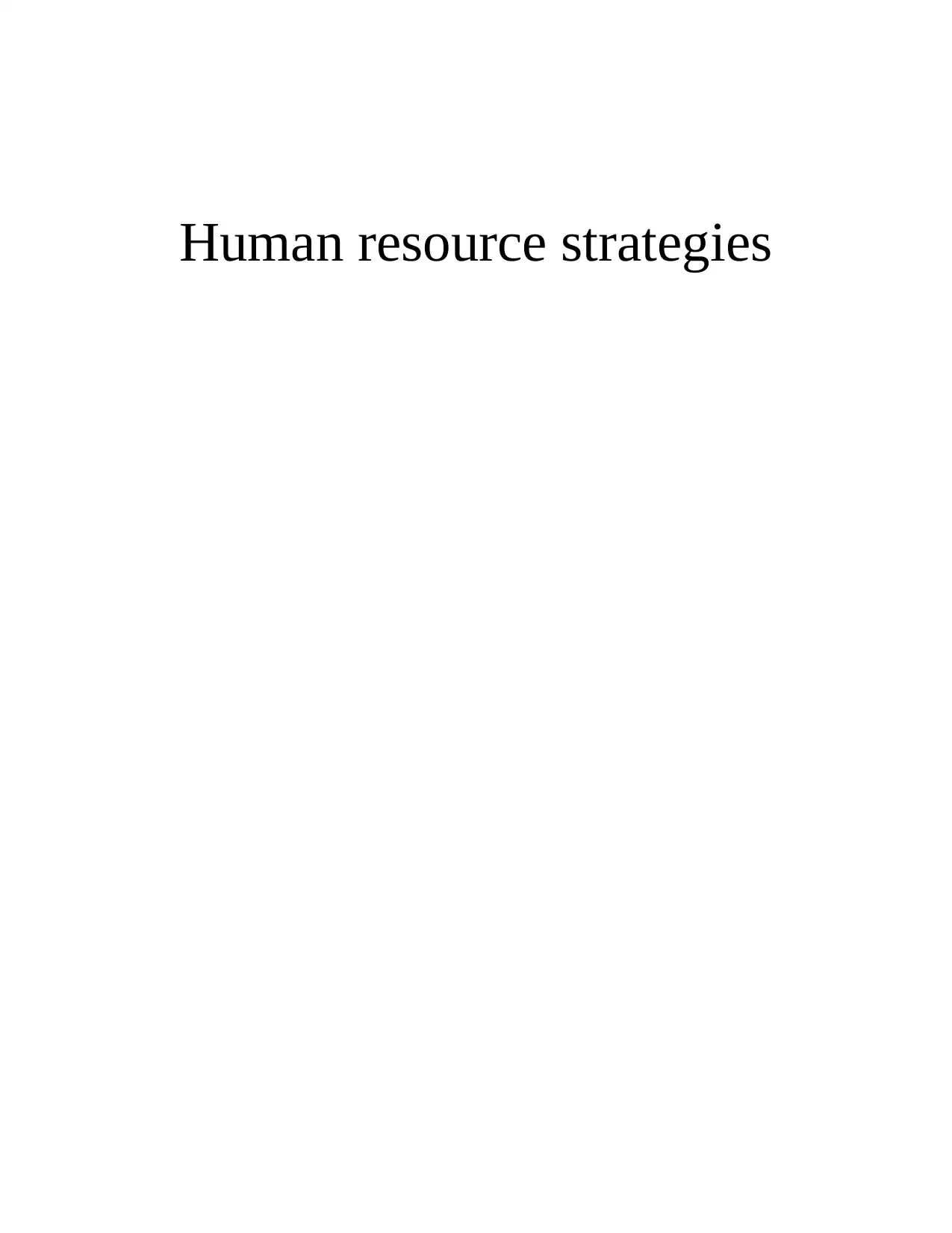
Human resource strategies
Paraphrase This Document
Need a fresh take? Get an instant paraphrase of this document with our AI Paraphraser
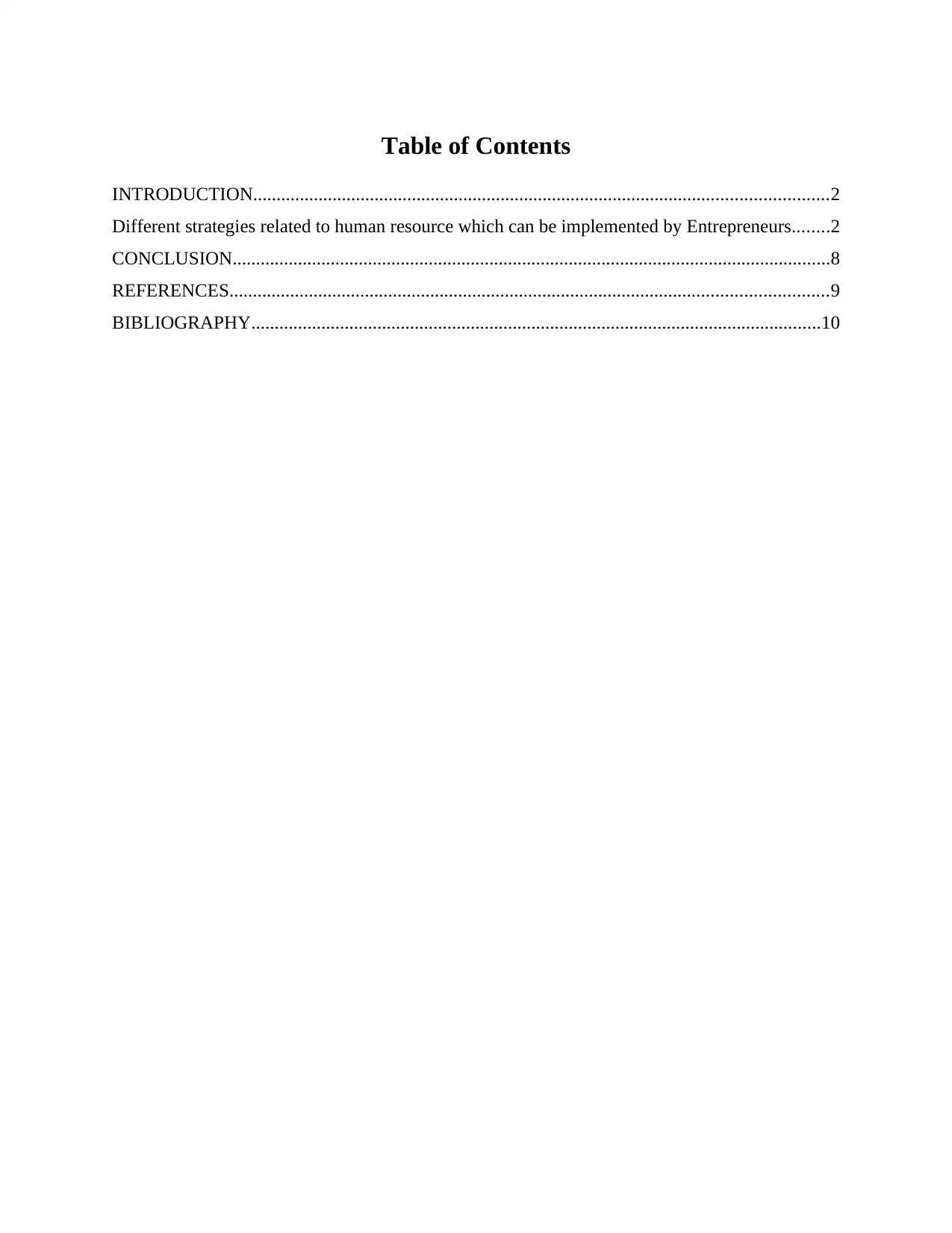
Table of Contents
INTRODUCTION...........................................................................................................................2
Different strategies related to human resource which can be implemented by Entrepreneurs........2
CONCLUSION................................................................................................................................8
REFERENCES................................................................................................................................9
BIBLIOGRAPHY..........................................................................................................................10
INTRODUCTION...........................................................................................................................2
Different strategies related to human resource which can be implemented by Entrepreneurs........2
CONCLUSION................................................................................................................................8
REFERENCES................................................................................................................................9
BIBLIOGRAPHY..........................................................................................................................10
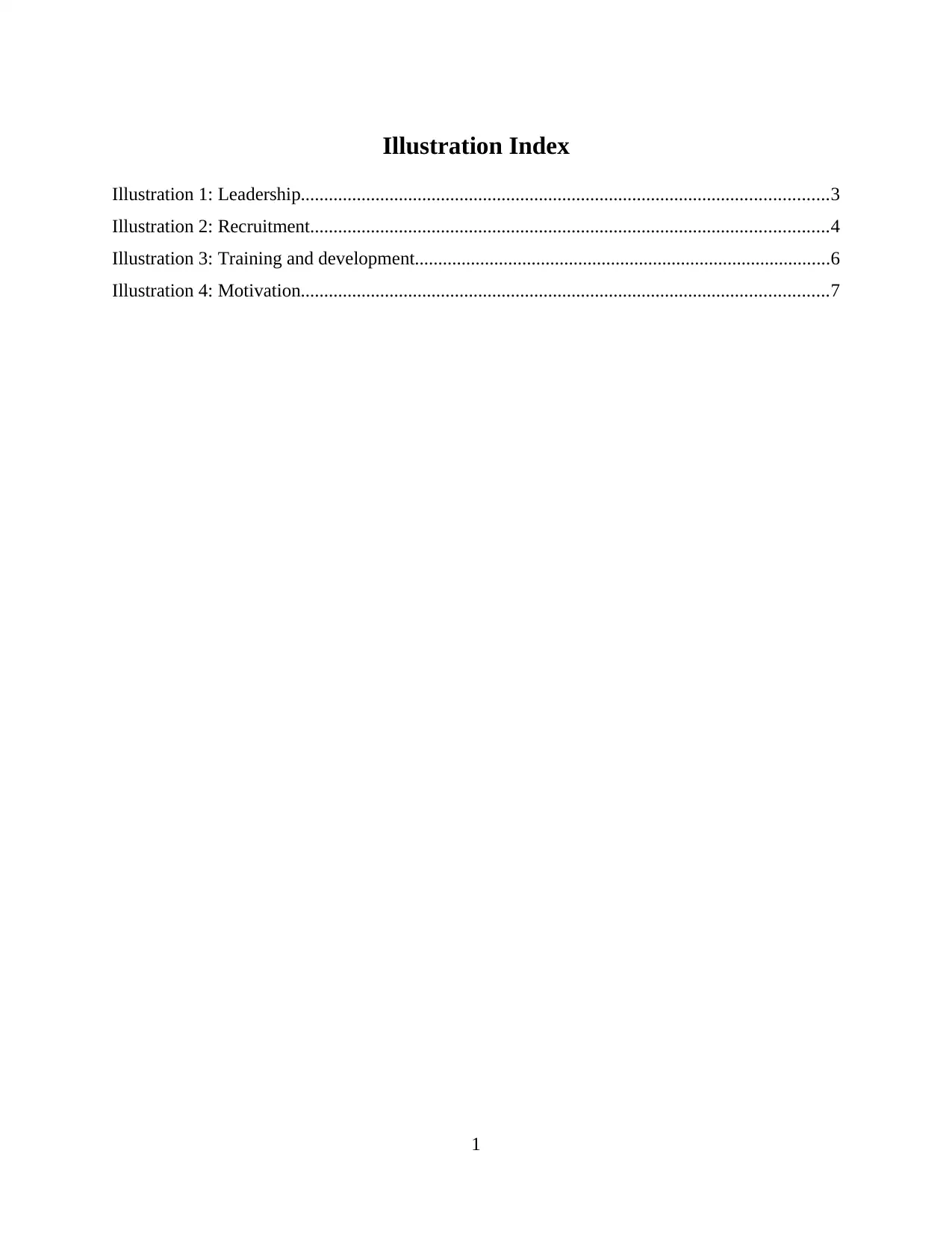
Illustration Index
Illustration 1: Leadership.................................................................................................................3
Illustration 2: Recruitment...............................................................................................................4
Illustration 3: Training and development.........................................................................................6
Illustration 4: Motivation.................................................................................................................7
1
Illustration 1: Leadership.................................................................................................................3
Illustration 2: Recruitment...............................................................................................................4
Illustration 3: Training and development.........................................................................................6
Illustration 4: Motivation.................................................................................................................7
1
⊘ This is a preview!⊘
Do you want full access?
Subscribe today to unlock all pages.

Trusted by 1+ million students worldwide
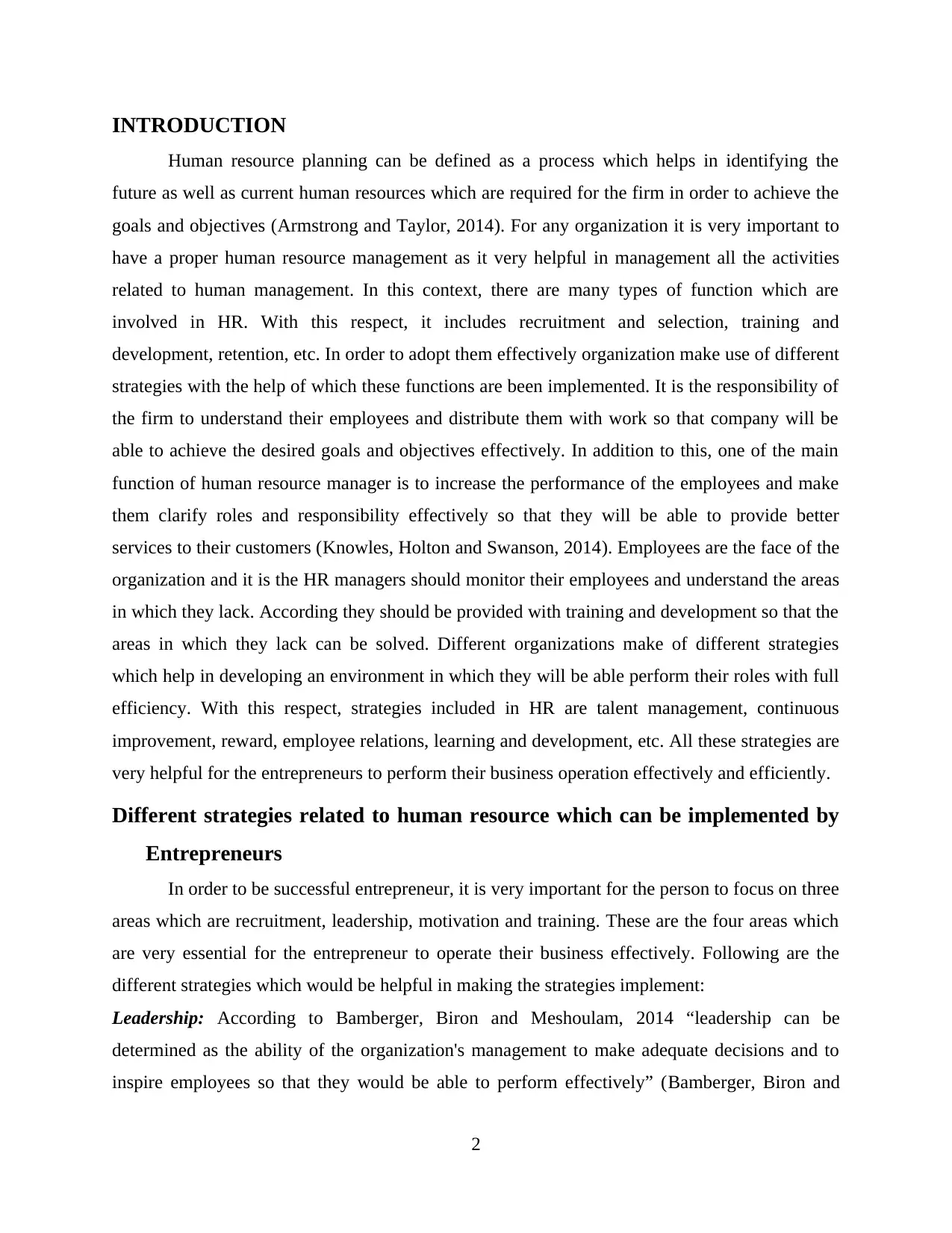
INTRODUCTION
Human resource planning can be defined as a process which helps in identifying the
future as well as current human resources which are required for the firm in order to achieve the
goals and objectives (Armstrong and Taylor, 2014). For any organization it is very important to
have a proper human resource management as it very helpful in management all the activities
related to human management. In this context, there are many types of function which are
involved in HR. With this respect, it includes recruitment and selection, training and
development, retention, etc. In order to adopt them effectively organization make use of different
strategies with the help of which these functions are been implemented. It is the responsibility of
the firm to understand their employees and distribute them with work so that company will be
able to achieve the desired goals and objectives effectively. In addition to this, one of the main
function of human resource manager is to increase the performance of the employees and make
them clarify roles and responsibility effectively so that they will be able to provide better
services to their customers (Knowles, Holton and Swanson, 2014). Employees are the face of the
organization and it is the HR managers should monitor their employees and understand the areas
in which they lack. According they should be provided with training and development so that the
areas in which they lack can be solved. Different organizations make of different strategies
which help in developing an environment in which they will be able perform their roles with full
efficiency. With this respect, strategies included in HR are talent management, continuous
improvement, reward, employee relations, learning and development, etc. All these strategies are
very helpful for the entrepreneurs to perform their business operation effectively and efficiently.
Different strategies related to human resource which can be implemented by
Entrepreneurs
In order to be successful entrepreneur, it is very important for the person to focus on three
areas which are recruitment, leadership, motivation and training. These are the four areas which
are very essential for the entrepreneur to operate their business effectively. Following are the
different strategies which would be helpful in making the strategies implement:
Leadership: According to Bamberger, Biron and Meshoulam, 2014 “leadership can be
determined as the ability of the organization's management to make adequate decisions and to
inspire employees so that they would be able to perform effectively” (Bamberger, Biron and
2
Human resource planning can be defined as a process which helps in identifying the
future as well as current human resources which are required for the firm in order to achieve the
goals and objectives (Armstrong and Taylor, 2014). For any organization it is very important to
have a proper human resource management as it very helpful in management all the activities
related to human management. In this context, there are many types of function which are
involved in HR. With this respect, it includes recruitment and selection, training and
development, retention, etc. In order to adopt them effectively organization make use of different
strategies with the help of which these functions are been implemented. It is the responsibility of
the firm to understand their employees and distribute them with work so that company will be
able to achieve the desired goals and objectives effectively. In addition to this, one of the main
function of human resource manager is to increase the performance of the employees and make
them clarify roles and responsibility effectively so that they will be able to provide better
services to their customers (Knowles, Holton and Swanson, 2014). Employees are the face of the
organization and it is the HR managers should monitor their employees and understand the areas
in which they lack. According they should be provided with training and development so that the
areas in which they lack can be solved. Different organizations make of different strategies
which help in developing an environment in which they will be able perform their roles with full
efficiency. With this respect, strategies included in HR are talent management, continuous
improvement, reward, employee relations, learning and development, etc. All these strategies are
very helpful for the entrepreneurs to perform their business operation effectively and efficiently.
Different strategies related to human resource which can be implemented by
Entrepreneurs
In order to be successful entrepreneur, it is very important for the person to focus on three
areas which are recruitment, leadership, motivation and training. These are the four areas which
are very essential for the entrepreneur to operate their business effectively. Following are the
different strategies which would be helpful in making the strategies implement:
Leadership: According to Bamberger, Biron and Meshoulam, 2014 “leadership can be
determined as the ability of the organization's management to make adequate decisions and to
inspire employees so that they would be able to perform effectively” (Bamberger, Biron and
2
Paraphrase This Document
Need a fresh take? Get an instant paraphrase of this document with our AI Paraphraser
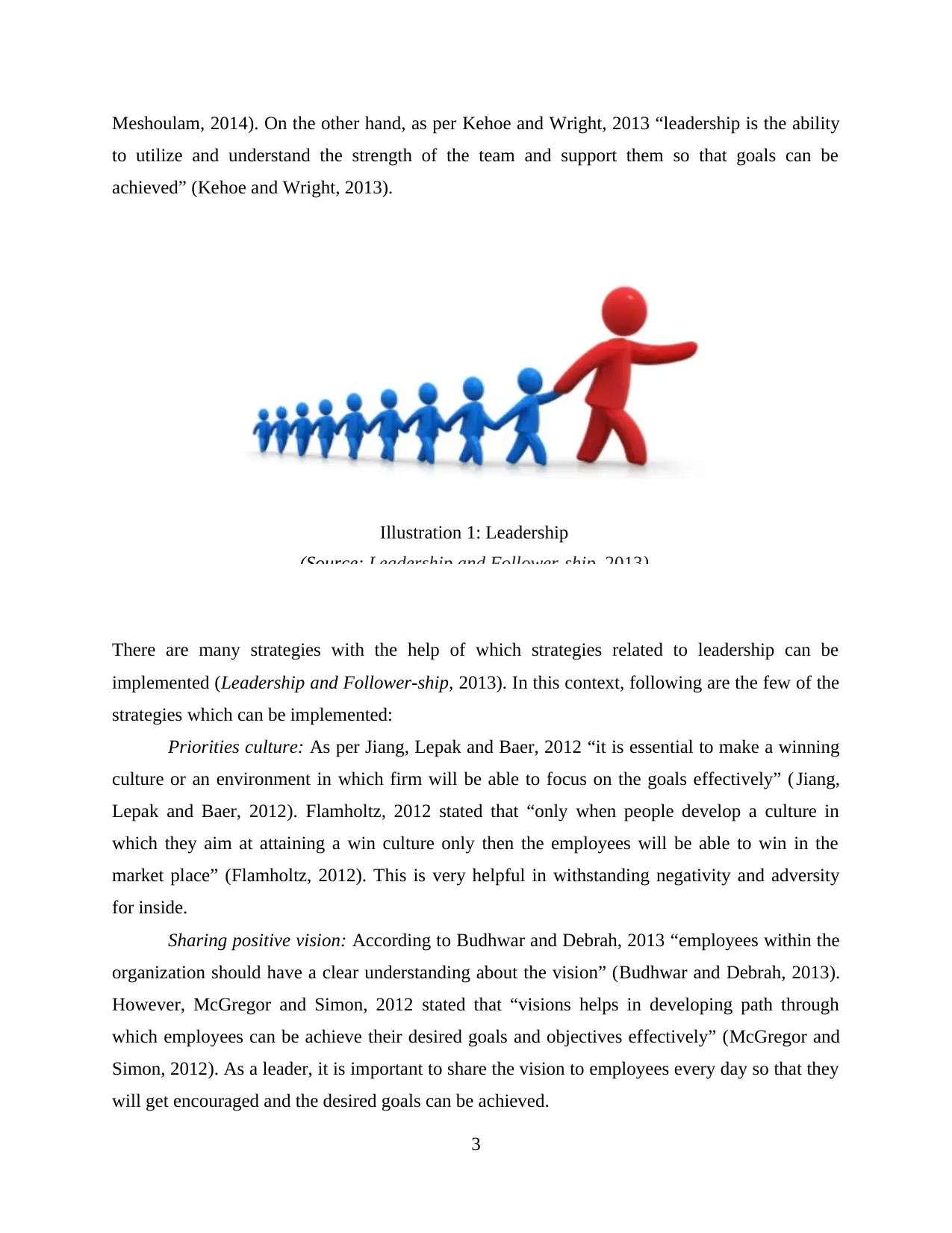
Meshoulam, 2014). On the other hand, as per Kehoe and Wright, 2013 “leadership is the ability
to utilize and understand the strength of the team and support them so that goals can be
achieved” (Kehoe and Wright, 2013).
There are many strategies with the help of which strategies related to leadership can be
implemented (Leadership and Follower-ship, 2013). In this context, following are the few of the
strategies which can be implemented:
Priorities culture: As per Jiang, Lepak and Baer, 2012 “it is essential to make a winning
culture or an environment in which firm will be able to focus on the goals effectively” ( Jiang,
Lepak and Baer, 2012). Flamholtz, 2012 stated that “only when people develop a culture in
which they aim at attaining a win culture only then the employees will be able to win in the
market place” (Flamholtz, 2012). This is very helpful in withstanding negativity and adversity
for inside.
Sharing positive vision: According to Budhwar and Debrah, 2013 “employees within the
organization should have a clear understanding about the vision” (Budhwar and Debrah, 2013).
However, McGregor and Simon, 2012 stated that “visions helps in developing path through
which employees can be achieve their desired goals and objectives effectively” (McGregor and
Simon, 2012). As a leader, it is important to share the vision to employees every day so that they
will get encouraged and the desired goals can be achieved.
3
Illustration 1: Leadership
(Source: Leadership and Follower-ship, 2013)
to utilize and understand the strength of the team and support them so that goals can be
achieved” (Kehoe and Wright, 2013).
There are many strategies with the help of which strategies related to leadership can be
implemented (Leadership and Follower-ship, 2013). In this context, following are the few of the
strategies which can be implemented:
Priorities culture: As per Jiang, Lepak and Baer, 2012 “it is essential to make a winning
culture or an environment in which firm will be able to focus on the goals effectively” ( Jiang,
Lepak and Baer, 2012). Flamholtz, 2012 stated that “only when people develop a culture in
which they aim at attaining a win culture only then the employees will be able to win in the
market place” (Flamholtz, 2012). This is very helpful in withstanding negativity and adversity
for inside.
Sharing positive vision: According to Budhwar and Debrah, 2013 “employees within the
organization should have a clear understanding about the vision” (Budhwar and Debrah, 2013).
However, McGregor and Simon, 2012 stated that “visions helps in developing path through
which employees can be achieve their desired goals and objectives effectively” (McGregor and
Simon, 2012). As a leader, it is important to share the vision to employees every day so that they
will get encouraged and the desired goals can be achieved.
3
Illustration 1: Leadership
(Source: Leadership and Follower-ship, 2013)
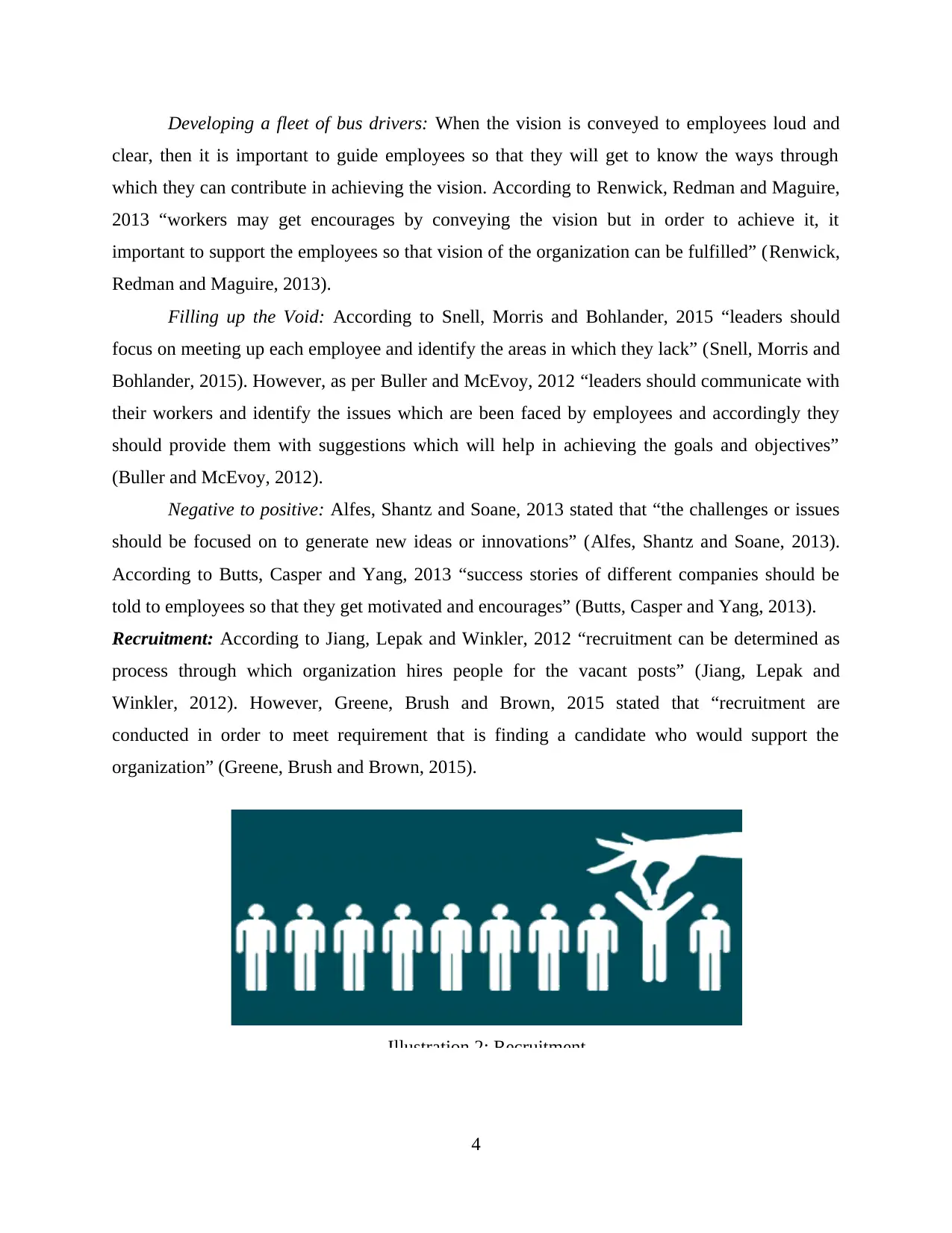
Developing a fleet of bus drivers: When the vision is conveyed to employees loud and
clear, then it is important to guide employees so that they will get to know the ways through
which they can contribute in achieving the vision. According to Renwick, Redman and Maguire,
2013 “workers may get encourages by conveying the vision but in order to achieve it, it
important to support the employees so that vision of the organization can be fulfilled” (Renwick,
Redman and Maguire, 2013).
Filling up the Void: According to Snell, Morris and Bohlander, 2015 “leaders should
focus on meeting up each employee and identify the areas in which they lack” (Snell, Morris and
Bohlander, 2015). However, as per Buller and McEvoy, 2012 “leaders should communicate with
their workers and identify the issues which are been faced by employees and accordingly they
should provide them with suggestions which will help in achieving the goals and objectives”
(Buller and McEvoy, 2012).
Negative to positive: Alfes, Shantz and Soane, 2013 stated that “the challenges or issues
should be focused on to generate new ideas or innovations” (Alfes, Shantz and Soane, 2013).
According to Butts, Casper and Yang, 2013 “success stories of different companies should be
told to employees so that they get motivated and encourages” (Butts, Casper and Yang, 2013).
Recruitment: According to Jiang, Lepak and Winkler, 2012 “recruitment can be determined as
process through which organization hires people for the vacant posts” (Jiang, Lepak and
Winkler, 2012). However, Greene, Brush and Brown, 2015 stated that “recruitment are
conducted in order to meet requirement that is finding a candidate who would support the
organization” (Greene, Brush and Brown, 2015).
4
Illustration 2: Recruitment
clear, then it is important to guide employees so that they will get to know the ways through
which they can contribute in achieving the vision. According to Renwick, Redman and Maguire,
2013 “workers may get encourages by conveying the vision but in order to achieve it, it
important to support the employees so that vision of the organization can be fulfilled” (Renwick,
Redman and Maguire, 2013).
Filling up the Void: According to Snell, Morris and Bohlander, 2015 “leaders should
focus on meeting up each employee and identify the areas in which they lack” (Snell, Morris and
Bohlander, 2015). However, as per Buller and McEvoy, 2012 “leaders should communicate with
their workers and identify the issues which are been faced by employees and accordingly they
should provide them with suggestions which will help in achieving the goals and objectives”
(Buller and McEvoy, 2012).
Negative to positive: Alfes, Shantz and Soane, 2013 stated that “the challenges or issues
should be focused on to generate new ideas or innovations” (Alfes, Shantz and Soane, 2013).
According to Butts, Casper and Yang, 2013 “success stories of different companies should be
told to employees so that they get motivated and encourages” (Butts, Casper and Yang, 2013).
Recruitment: According to Jiang, Lepak and Winkler, 2012 “recruitment can be determined as
process through which organization hires people for the vacant posts” (Jiang, Lepak and
Winkler, 2012). However, Greene, Brush and Brown, 2015 stated that “recruitment are
conducted in order to meet requirement that is finding a candidate who would support the
organization” (Greene, Brush and Brown, 2015).
4
Illustration 2: Recruitment
⊘ This is a preview!⊘
Do you want full access?
Subscribe today to unlock all pages.

Trusted by 1+ million students worldwide
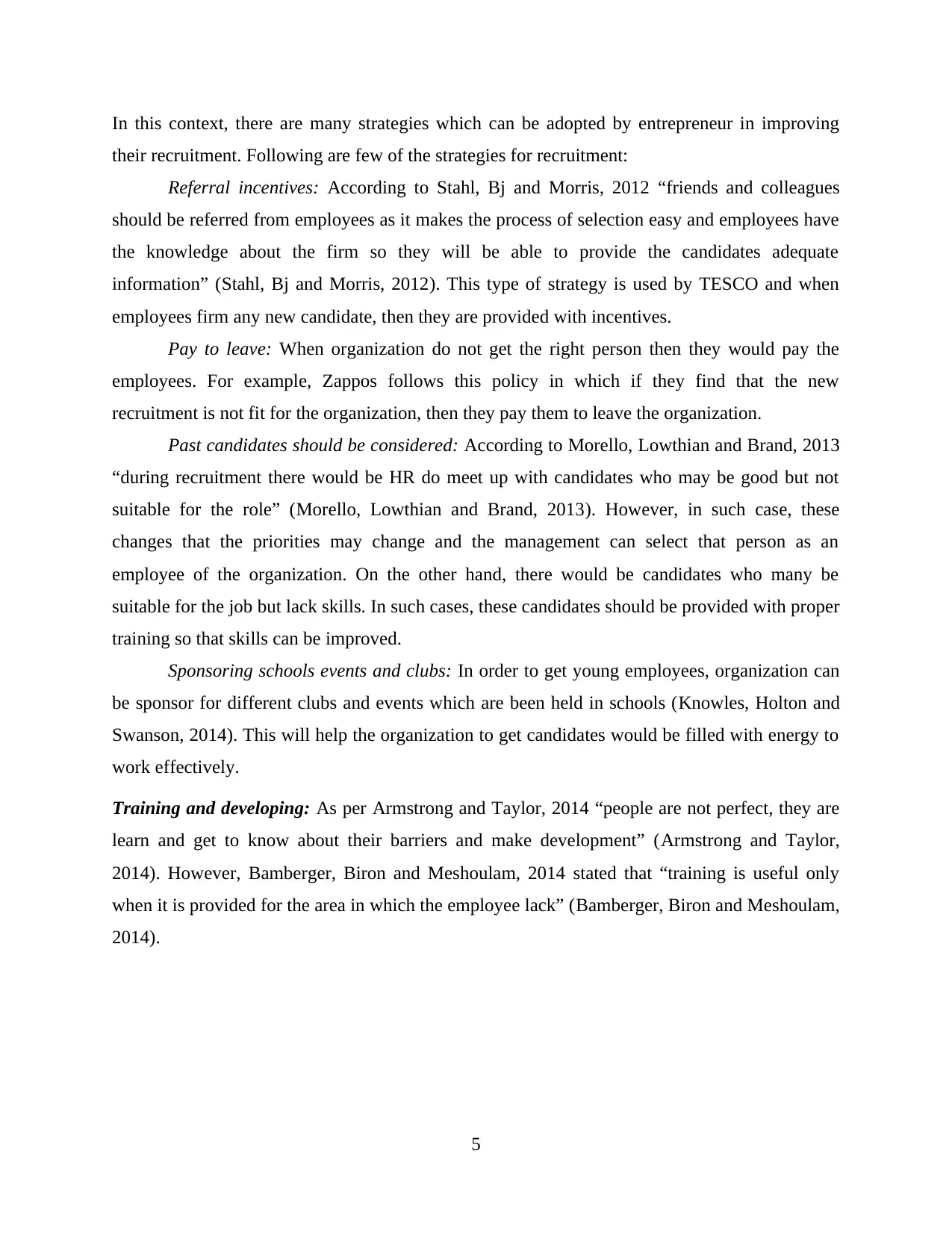
In this context, there are many strategies which can be adopted by entrepreneur in improving
their recruitment. Following are few of the strategies for recruitment:
Referral incentives: According to Stahl, Bj and Morris, 2012 “friends and colleagues
should be referred from employees as it makes the process of selection easy and employees have
the knowledge about the firm so they will be able to provide the candidates adequate
information” (Stahl, Bj and Morris, 2012). This type of strategy is used by TESCO and when
employees firm any new candidate, then they are provided with incentives.
Pay to leave: When organization do not get the right person then they would pay the
employees. For example, Zappos follows this policy in which if they find that the new
recruitment is not fit for the organization, then they pay them to leave the organization.
Past candidates should be considered: According to Morello, Lowthian and Brand, 2013
“during recruitment there would be HR do meet up with candidates who may be good but not
suitable for the role” (Morello, Lowthian and Brand, 2013). However, in such case, these
changes that the priorities may change and the management can select that person as an
employee of the organization. On the other hand, there would be candidates who many be
suitable for the job but lack skills. In such cases, these candidates should be provided with proper
training so that skills can be improved.
Sponsoring schools events and clubs: In order to get young employees, organization can
be sponsor for different clubs and events which are been held in schools (Knowles, Holton and
Swanson, 2014). This will help the organization to get candidates would be filled with energy to
work effectively.
Training and developing: As per Armstrong and Taylor, 2014 “people are not perfect, they are
learn and get to know about their barriers and make development” (Armstrong and Taylor,
2014). However, Bamberger, Biron and Meshoulam, 2014 stated that “training is useful only
when it is provided for the area in which the employee lack” (Bamberger, Biron and Meshoulam,
2014).
5
their recruitment. Following are few of the strategies for recruitment:
Referral incentives: According to Stahl, Bj and Morris, 2012 “friends and colleagues
should be referred from employees as it makes the process of selection easy and employees have
the knowledge about the firm so they will be able to provide the candidates adequate
information” (Stahl, Bj and Morris, 2012). This type of strategy is used by TESCO and when
employees firm any new candidate, then they are provided with incentives.
Pay to leave: When organization do not get the right person then they would pay the
employees. For example, Zappos follows this policy in which if they find that the new
recruitment is not fit for the organization, then they pay them to leave the organization.
Past candidates should be considered: According to Morello, Lowthian and Brand, 2013
“during recruitment there would be HR do meet up with candidates who may be good but not
suitable for the role” (Morello, Lowthian and Brand, 2013). However, in such case, these
changes that the priorities may change and the management can select that person as an
employee of the organization. On the other hand, there would be candidates who many be
suitable for the job but lack skills. In such cases, these candidates should be provided with proper
training so that skills can be improved.
Sponsoring schools events and clubs: In order to get young employees, organization can
be sponsor for different clubs and events which are been held in schools (Knowles, Holton and
Swanson, 2014). This will help the organization to get candidates would be filled with energy to
work effectively.
Training and developing: As per Armstrong and Taylor, 2014 “people are not perfect, they are
learn and get to know about their barriers and make development” (Armstrong and Taylor,
2014). However, Bamberger, Biron and Meshoulam, 2014 stated that “training is useful only
when it is provided for the area in which the employee lack” (Bamberger, Biron and Meshoulam,
2014).
5
Paraphrase This Document
Need a fresh take? Get an instant paraphrase of this document with our AI Paraphraser
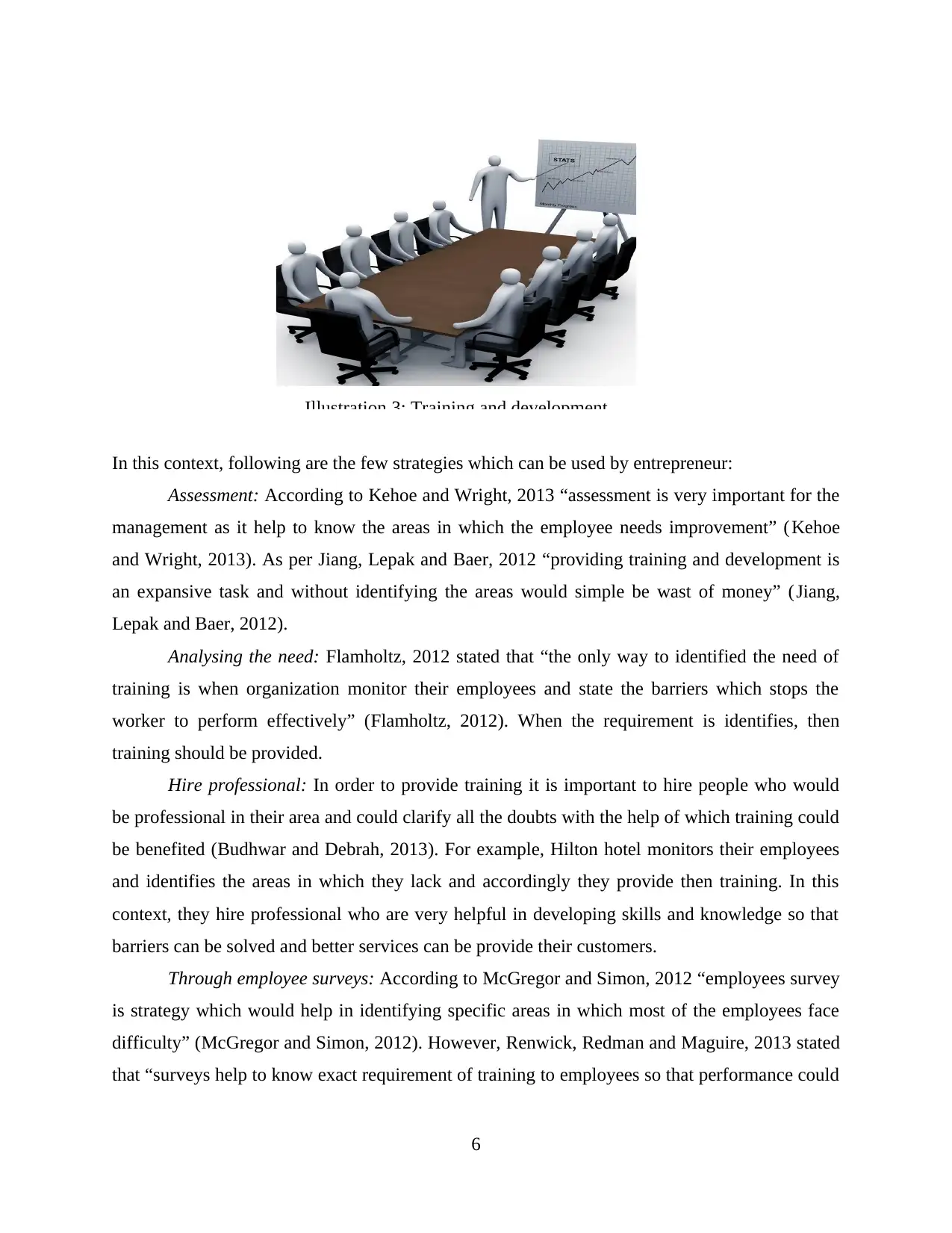
In this context, following are the few strategies which can be used by entrepreneur:
Assessment: According to Kehoe and Wright, 2013 “assessment is very important for the
management as it help to know the areas in which the employee needs improvement” (Kehoe
and Wright, 2013). As per Jiang, Lepak and Baer, 2012 “providing training and development is
an expansive task and without identifying the areas would simple be wast of money” (Jiang,
Lepak and Baer, 2012).
Analysing the need: Flamholtz, 2012 stated that “the only way to identified the need of
training is when organization monitor their employees and state the barriers which stops the
worker to perform effectively” (Flamholtz, 2012). When the requirement is identifies, then
training should be provided.
Hire professional: In order to provide training it is important to hire people who would
be professional in their area and could clarify all the doubts with the help of which training could
be benefited (Budhwar and Debrah, 2013). For example, Hilton hotel monitors their employees
and identifies the areas in which they lack and accordingly they provide then training. In this
context, they hire professional who are very helpful in developing skills and knowledge so that
barriers can be solved and better services can be provide their customers.
Through employee surveys: According to McGregor and Simon, 2012 “employees survey
is strategy which would help in identifying specific areas in which most of the employees face
difficulty” (McGregor and Simon, 2012). However, Renwick, Redman and Maguire, 2013 stated
that “surveys help to know exact requirement of training to employees so that performance could
6
Illustration 3: Training and development
Assessment: According to Kehoe and Wright, 2013 “assessment is very important for the
management as it help to know the areas in which the employee needs improvement” (Kehoe
and Wright, 2013). As per Jiang, Lepak and Baer, 2012 “providing training and development is
an expansive task and without identifying the areas would simple be wast of money” (Jiang,
Lepak and Baer, 2012).
Analysing the need: Flamholtz, 2012 stated that “the only way to identified the need of
training is when organization monitor their employees and state the barriers which stops the
worker to perform effectively” (Flamholtz, 2012). When the requirement is identifies, then
training should be provided.
Hire professional: In order to provide training it is important to hire people who would
be professional in their area and could clarify all the doubts with the help of which training could
be benefited (Budhwar and Debrah, 2013). For example, Hilton hotel monitors their employees
and identifies the areas in which they lack and accordingly they provide then training. In this
context, they hire professional who are very helpful in developing skills and knowledge so that
barriers can be solved and better services can be provide their customers.
Through employee surveys: According to McGregor and Simon, 2012 “employees survey
is strategy which would help in identifying specific areas in which most of the employees face
difficulty” (McGregor and Simon, 2012). However, Renwick, Redman and Maguire, 2013 stated
that “surveys help to know exact requirement of training to employees so that performance could
6
Illustration 3: Training and development
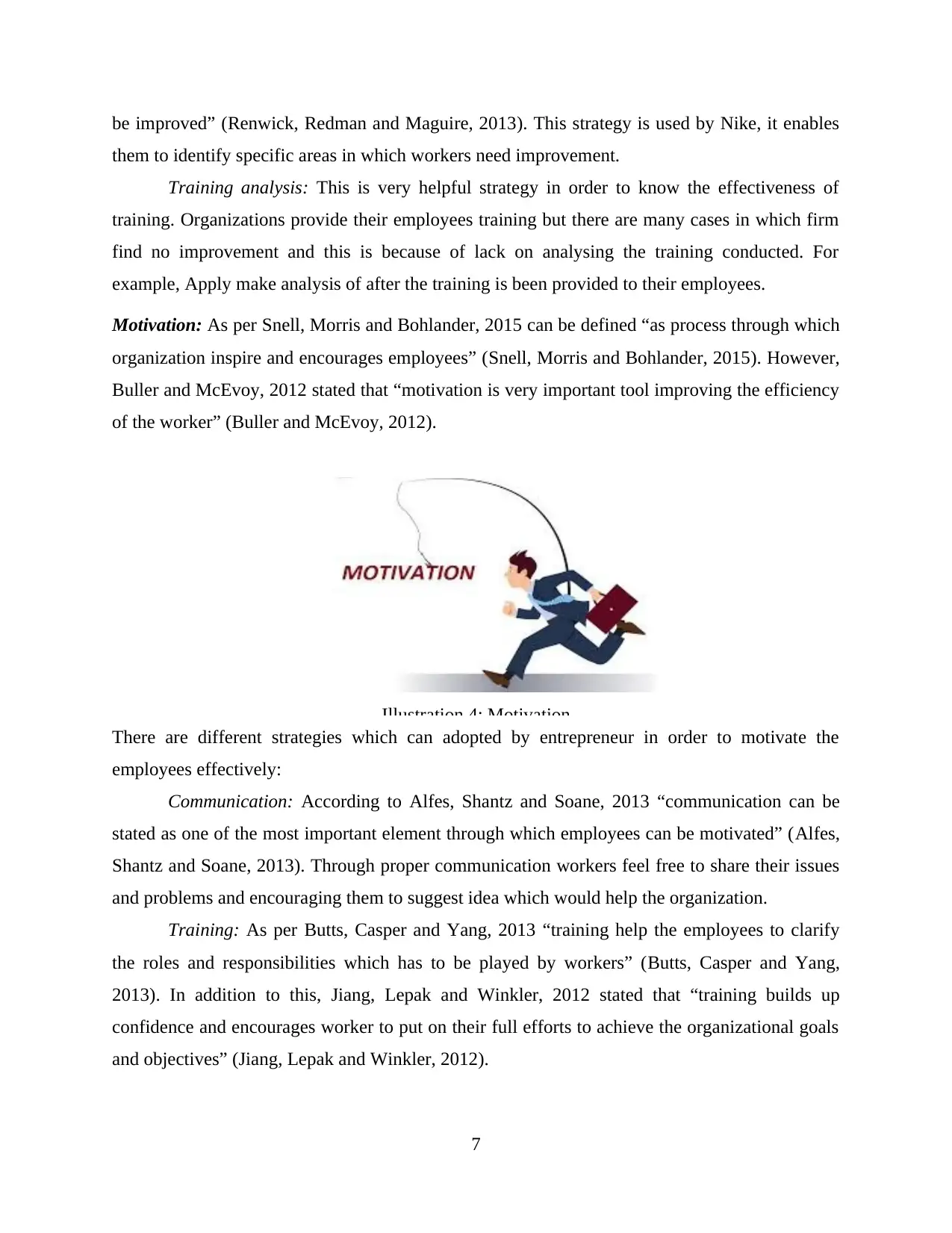
be improved” (Renwick, Redman and Maguire, 2013). This strategy is used by Nike, it enables
them to identify specific areas in which workers need improvement.
Training analysis: This is very helpful strategy in order to know the effectiveness of
training. Organizations provide their employees training but there are many cases in which firm
find no improvement and this is because of lack on analysing the training conducted. For
example, Apply make analysis of after the training is been provided to their employees.
Motivation: As per Snell, Morris and Bohlander, 2015 can be defined “as process through which
organization inspire and encourages employees” (Snell, Morris and Bohlander, 2015). However,
Buller and McEvoy, 2012 stated that “motivation is very important tool improving the efficiency
of the worker” (Buller and McEvoy, 2012).
There are different strategies which can adopted by entrepreneur in order to motivate the
employees effectively:
Communication: According to Alfes, Shantz and Soane, 2013 “communication can be
stated as one of the most important element through which employees can be motivated” (Alfes,
Shantz and Soane, 2013). Through proper communication workers feel free to share their issues
and problems and encouraging them to suggest idea which would help the organization.
Training: As per Butts, Casper and Yang, 2013 “training help the employees to clarify
the roles and responsibilities which has to be played by workers” (Butts, Casper and Yang,
2013). In addition to this, Jiang, Lepak and Winkler, 2012 stated that “training builds up
confidence and encourages worker to put on their full efforts to achieve the organizational goals
and objectives” (Jiang, Lepak and Winkler, 2012).
7
Illustration 4: Motivation
them to identify specific areas in which workers need improvement.
Training analysis: This is very helpful strategy in order to know the effectiveness of
training. Organizations provide their employees training but there are many cases in which firm
find no improvement and this is because of lack on analysing the training conducted. For
example, Apply make analysis of after the training is been provided to their employees.
Motivation: As per Snell, Morris and Bohlander, 2015 can be defined “as process through which
organization inspire and encourages employees” (Snell, Morris and Bohlander, 2015). However,
Buller and McEvoy, 2012 stated that “motivation is very important tool improving the efficiency
of the worker” (Buller and McEvoy, 2012).
There are different strategies which can adopted by entrepreneur in order to motivate the
employees effectively:
Communication: According to Alfes, Shantz and Soane, 2013 “communication can be
stated as one of the most important element through which employees can be motivated” (Alfes,
Shantz and Soane, 2013). Through proper communication workers feel free to share their issues
and problems and encouraging them to suggest idea which would help the organization.
Training: As per Butts, Casper and Yang, 2013 “training help the employees to clarify
the roles and responsibilities which has to be played by workers” (Butts, Casper and Yang,
2013). In addition to this, Jiang, Lepak and Winkler, 2012 stated that “training builds up
confidence and encourages worker to put on their full efforts to achieve the organizational goals
and objectives” (Jiang, Lepak and Winkler, 2012).
7
Illustration 4: Motivation
⊘ This is a preview!⊘
Do you want full access?
Subscribe today to unlock all pages.

Trusted by 1+ million students worldwide
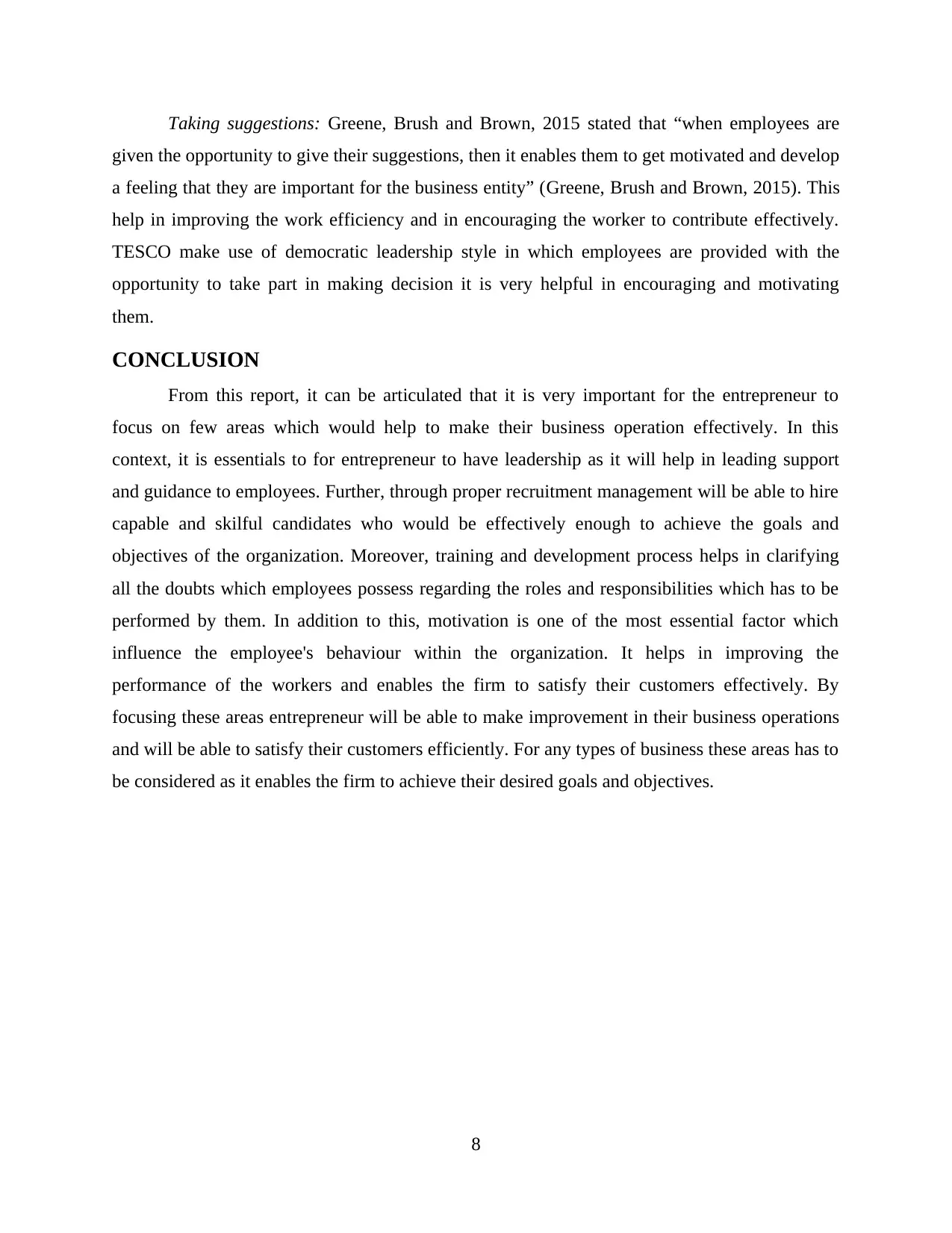
Taking suggestions: Greene, Brush and Brown, 2015 stated that “when employees are
given the opportunity to give their suggestions, then it enables them to get motivated and develop
a feeling that they are important for the business entity” (Greene, Brush and Brown, 2015). This
help in improving the work efficiency and in encouraging the worker to contribute effectively.
TESCO make use of democratic leadership style in which employees are provided with the
opportunity to take part in making decision it is very helpful in encouraging and motivating
them.
CONCLUSION
From this report, it can be articulated that it is very important for the entrepreneur to
focus on few areas which would help to make their business operation effectively. In this
context, it is essentials to for entrepreneur to have leadership as it will help in leading support
and guidance to employees. Further, through proper recruitment management will be able to hire
capable and skilful candidates who would be effectively enough to achieve the goals and
objectives of the organization. Moreover, training and development process helps in clarifying
all the doubts which employees possess regarding the roles and responsibilities which has to be
performed by them. In addition to this, motivation is one of the most essential factor which
influence the employee's behaviour within the organization. It helps in improving the
performance of the workers and enables the firm to satisfy their customers effectively. By
focusing these areas entrepreneur will be able to make improvement in their business operations
and will be able to satisfy their customers efficiently. For any types of business these areas has to
be considered as it enables the firm to achieve their desired goals and objectives.
8
given the opportunity to give their suggestions, then it enables them to get motivated and develop
a feeling that they are important for the business entity” (Greene, Brush and Brown, 2015). This
help in improving the work efficiency and in encouraging the worker to contribute effectively.
TESCO make use of democratic leadership style in which employees are provided with the
opportunity to take part in making decision it is very helpful in encouraging and motivating
them.
CONCLUSION
From this report, it can be articulated that it is very important for the entrepreneur to
focus on few areas which would help to make their business operation effectively. In this
context, it is essentials to for entrepreneur to have leadership as it will help in leading support
and guidance to employees. Further, through proper recruitment management will be able to hire
capable and skilful candidates who would be effectively enough to achieve the goals and
objectives of the organization. Moreover, training and development process helps in clarifying
all the doubts which employees possess regarding the roles and responsibilities which has to be
performed by them. In addition to this, motivation is one of the most essential factor which
influence the employee's behaviour within the organization. It helps in improving the
performance of the workers and enables the firm to satisfy their customers effectively. By
focusing these areas entrepreneur will be able to make improvement in their business operations
and will be able to satisfy their customers efficiently. For any types of business these areas has to
be considered as it enables the firm to achieve their desired goals and objectives.
8
Paraphrase This Document
Need a fresh take? Get an instant paraphrase of this document with our AI Paraphraser
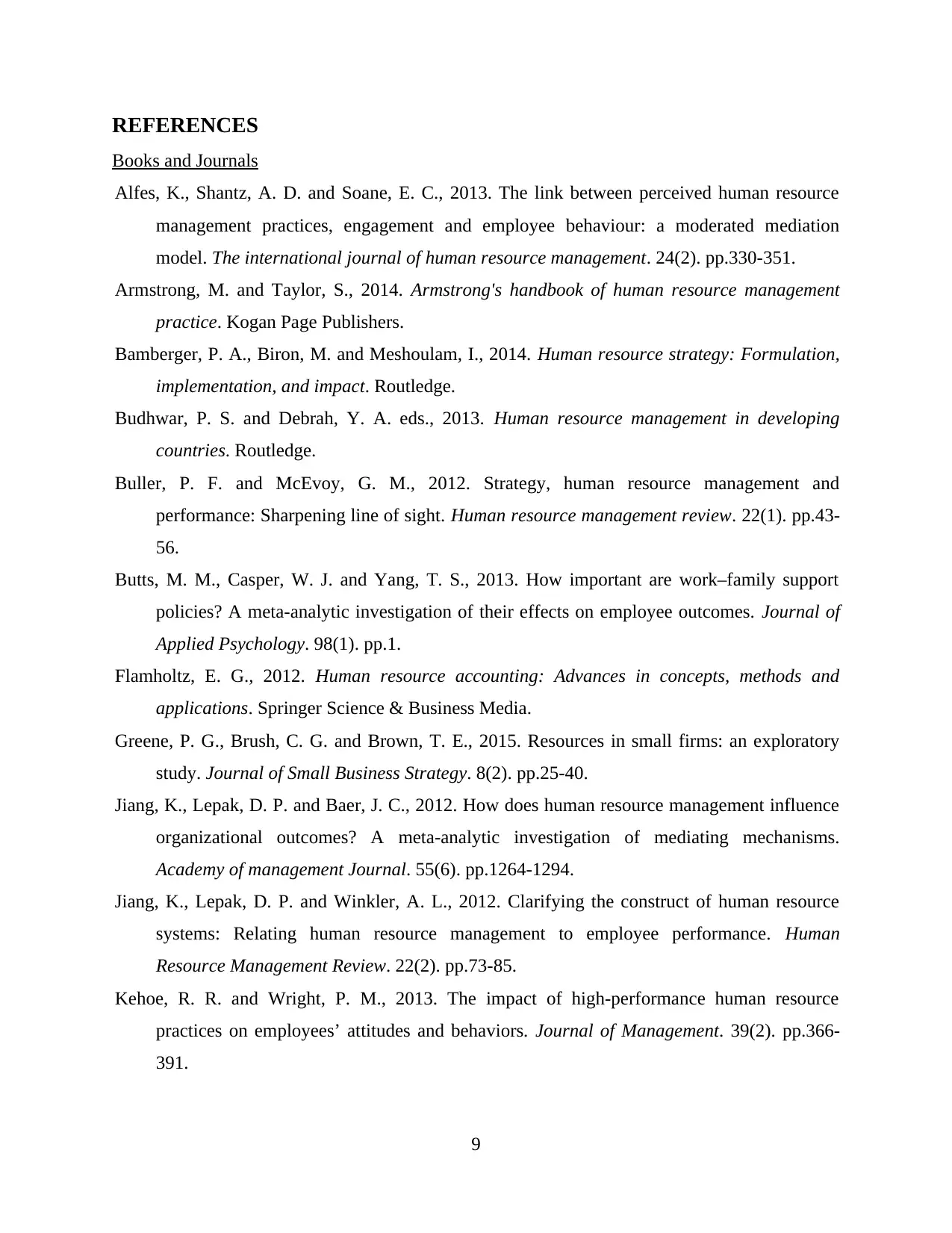
REFERENCES
Books and Journals
Alfes, K., Shantz, A. D. and Soane, E. C., 2013. The link between perceived human resource
management practices, engagement and employee behaviour: a moderated mediation
model. The international journal of human resource management. 24(2). pp.330-351.
Armstrong, M. and Taylor, S., 2014. Armstrong's handbook of human resource management
practice. Kogan Page Publishers.
Bamberger, P. A., Biron, M. and Meshoulam, I., 2014. Human resource strategy: Formulation,
implementation, and impact. Routledge.
Budhwar, P. S. and Debrah, Y. A. eds., 2013. Human resource management in developing
countries. Routledge.
Buller, P. F. and McEvoy, G. M., 2012. Strategy, human resource management and
performance: Sharpening line of sight. Human resource management review. 22(1). pp.43-
56.
Butts, M. M., Casper, W. J. and Yang, T. S., 2013. How important are work–family support
policies? A meta-analytic investigation of their effects on employee outcomes. Journal of
Applied Psychology. 98(1). pp.1.
Flamholtz, E. G., 2012. Human resource accounting: Advances in concepts, methods and
applications. Springer Science & Business Media.
Greene, P. G., Brush, C. G. and Brown, T. E., 2015. Resources in small firms: an exploratory
study. Journal of Small Business Strategy. 8(2). pp.25-40.
Jiang, K., Lepak, D. P. and Baer, J. C., 2012. How does human resource management influence
organizational outcomes? A meta-analytic investigation of mediating mechanisms.
Academy of management Journal. 55(6). pp.1264-1294.
Jiang, K., Lepak, D. P. and Winkler, A. L., 2012. Clarifying the construct of human resource
systems: Relating human resource management to employee performance. Human
Resource Management Review. 22(2). pp.73-85.
Kehoe, R. R. and Wright, P. M., 2013. The impact of high-performance human resource
practices on employees’ attitudes and behaviors. Journal of Management. 39(2). pp.366-
391.
9
Books and Journals
Alfes, K., Shantz, A. D. and Soane, E. C., 2013. The link between perceived human resource
management practices, engagement and employee behaviour: a moderated mediation
model. The international journal of human resource management. 24(2). pp.330-351.
Armstrong, M. and Taylor, S., 2014. Armstrong's handbook of human resource management
practice. Kogan Page Publishers.
Bamberger, P. A., Biron, M. and Meshoulam, I., 2014. Human resource strategy: Formulation,
implementation, and impact. Routledge.
Budhwar, P. S. and Debrah, Y. A. eds., 2013. Human resource management in developing
countries. Routledge.
Buller, P. F. and McEvoy, G. M., 2012. Strategy, human resource management and
performance: Sharpening line of sight. Human resource management review. 22(1). pp.43-
56.
Butts, M. M., Casper, W. J. and Yang, T. S., 2013. How important are work–family support
policies? A meta-analytic investigation of their effects on employee outcomes. Journal of
Applied Psychology. 98(1). pp.1.
Flamholtz, E. G., 2012. Human resource accounting: Advances in concepts, methods and
applications. Springer Science & Business Media.
Greene, P. G., Brush, C. G. and Brown, T. E., 2015. Resources in small firms: an exploratory
study. Journal of Small Business Strategy. 8(2). pp.25-40.
Jiang, K., Lepak, D. P. and Baer, J. C., 2012. How does human resource management influence
organizational outcomes? A meta-analytic investigation of mediating mechanisms.
Academy of management Journal. 55(6). pp.1264-1294.
Jiang, K., Lepak, D. P. and Winkler, A. L., 2012. Clarifying the construct of human resource
systems: Relating human resource management to employee performance. Human
Resource Management Review. 22(2). pp.73-85.
Kehoe, R. R. and Wright, P. M., 2013. The impact of high-performance human resource
practices on employees’ attitudes and behaviors. Journal of Management. 39(2). pp.366-
391.
9
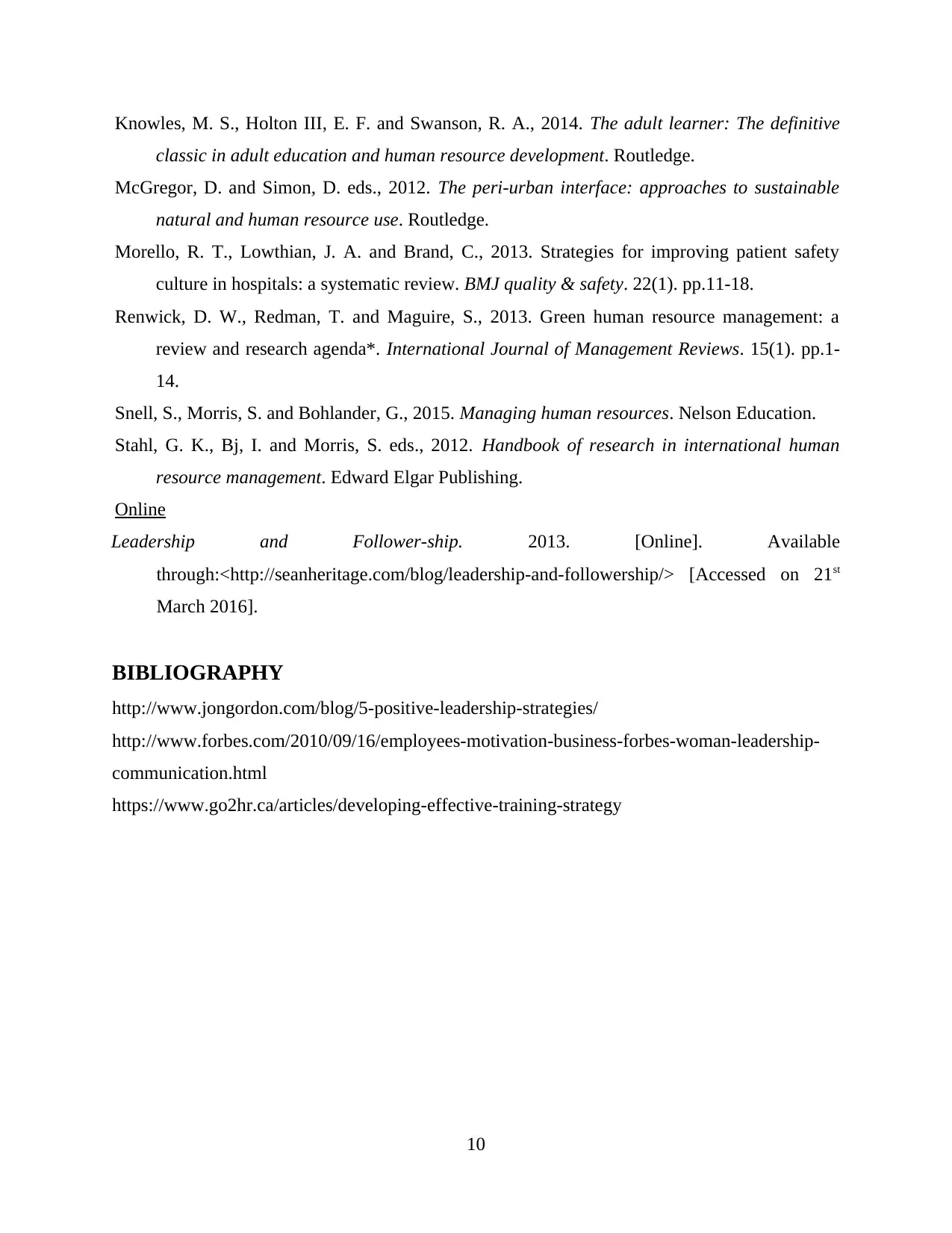
Knowles, M. S., Holton III, E. F. and Swanson, R. A., 2014. The adult learner: The definitive
classic in adult education and human resource development. Routledge.
McGregor, D. and Simon, D. eds., 2012. The peri-urban interface: approaches to sustainable
natural and human resource use. Routledge.
Morello, R. T., Lowthian, J. A. and Brand, C., 2013. Strategies for improving patient safety
culture in hospitals: a systematic review. BMJ quality & safety. 22(1). pp.11-18.
Renwick, D. W., Redman, T. and Maguire, S., 2013. Green human resource management: a
review and research agenda*. International Journal of Management Reviews. 15(1). pp.1-
14.
Snell, S., Morris, S. and Bohlander, G., 2015. Managing human resources. Nelson Education.
Stahl, G. K., Bj, I. and Morris, S. eds., 2012. Handbook of research in international human
resource management. Edward Elgar Publishing.
Online
Leadership and Follower-ship. 2013. [Online]. Available
through:<http://seanheritage.com/blog/leadership-and-followership/> [Accessed on 21st
March 2016].
BIBLIOGRAPHY
http://www.jongordon.com/blog/5-positive-leadership-strategies/
http://www.forbes.com/2010/09/16/employees-motivation-business-forbes-woman-leadership-
communication.html
https://www.go2hr.ca/articles/developing-effective-training-strategy
10
classic in adult education and human resource development. Routledge.
McGregor, D. and Simon, D. eds., 2012. The peri-urban interface: approaches to sustainable
natural and human resource use. Routledge.
Morello, R. T., Lowthian, J. A. and Brand, C., 2013. Strategies for improving patient safety
culture in hospitals: a systematic review. BMJ quality & safety. 22(1). pp.11-18.
Renwick, D. W., Redman, T. and Maguire, S., 2013. Green human resource management: a
review and research agenda*. International Journal of Management Reviews. 15(1). pp.1-
14.
Snell, S., Morris, S. and Bohlander, G., 2015. Managing human resources. Nelson Education.
Stahl, G. K., Bj, I. and Morris, S. eds., 2012. Handbook of research in international human
resource management. Edward Elgar Publishing.
Online
Leadership and Follower-ship. 2013. [Online]. Available
through:<http://seanheritage.com/blog/leadership-and-followership/> [Accessed on 21st
March 2016].
BIBLIOGRAPHY
http://www.jongordon.com/blog/5-positive-leadership-strategies/
http://www.forbes.com/2010/09/16/employees-motivation-business-forbes-woman-leadership-
communication.html
https://www.go2hr.ca/articles/developing-effective-training-strategy
10
⊘ This is a preview!⊘
Do you want full access?
Subscribe today to unlock all pages.

Trusted by 1+ million students worldwide
1 out of 12
Related Documents
Your All-in-One AI-Powered Toolkit for Academic Success.
+13062052269
info@desklib.com
Available 24*7 on WhatsApp / Email
![[object Object]](/_next/static/media/star-bottom.7253800d.svg)
Unlock your academic potential
Copyright © 2020–2025 A2Z Services. All Rights Reserved. Developed and managed by ZUCOL.




